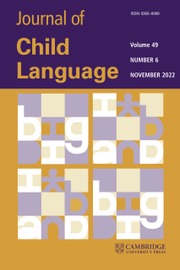Article contents
Lexical segmentation and vocabulary growth in early language acquisition*
Published online by Cambridge University Press: 26 September 2008
Abstract
The identification of appropriate lexical segmentations of the speech signal constitutes a problem for the language learner and the child language researcher alike. Articulatory precision and fluency criteria for identifying formulaic expressions, sub-lexical forms and target lexemes in linguistic productions are defined and applied to the analysis of two Danish children's language development between the ages of 1;0 and 2;0. The results of this analysis are compared to the results of applying standard distributional and frequency criteria in the tabulation of mean length of utterance and vocabulary profiles for both standard and nonstandard lexical segmentations. It is argued that although the two methods yield converging profiles of development during the latter part of the period studied, articulatory precision and fluency criteria offer a more powerful tool for identifying alternative segmentation strategies in early language acquisition. Profiles of vocabulary development for these two children suggest that the solution to the segmentation problem may be an important trigger for their vocabulary spurts.
Information
- Type
- Articles
- Information
- Copyright
- Copyright © Cambridge University Press 1993
Footnotes
I would like to thank Judith Goodman for advice and encouragement during the writing of several drafts of the manuscript and also Elizabeth Bates, Virginia Marchman, Ann Peters and Donna Thal for detailed comments on earlier drafts.
References
REFERENCES
- 65
- Cited by

